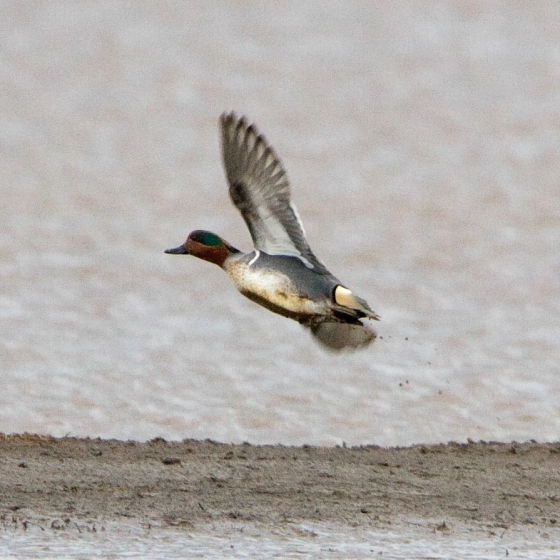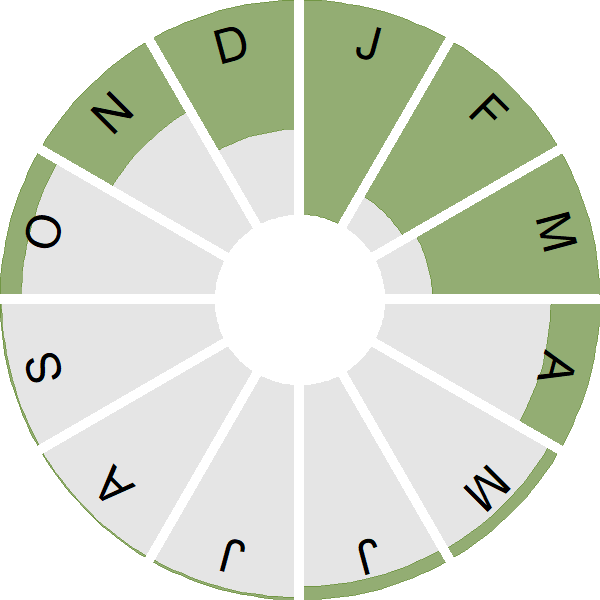Green-winged Teal

Introduction
Very similar to our Teal (and considered a subspecies by some) this is a scarce, but annual, visitor from North America; most records are in autumn/winter and almost all proven ones are male.

Key Stats
Status and Trends
Conservation Status
Population Size
Population Change
Population trends of this scarce species are not routinely monitored.
Distribution
This species is a rare vagrant and was recorded during Bird Atlas 2007–11 as shown on the map.
Occupied 10-km squares in UK
2007/08–10/11
or view it on Bird Atlas Mapstore.
2008–11
or view it on Bird Atlas Mapstore.
Distribution Change
This vagrant has been recorded in several atlases so we have been able to map distribution changes. However, as a rarity these may not show a consistent pattern of change.
Change in occupied 10-km squares in the UK
from 1981–84 to 2007–11
or view it on Bird Atlas Mapstore.
from 1968–72 to 2008–11
or view it on Bird Atlas Mapstore.
Seasonality
Green-winged Teal is a rare vagrant, usually encountered in winter among flocks of Teal.
Weekly pattern of occurrence
The graph shows when the species is present in the UK, with taller bars indicating a higher likelihood of encountering the species in appropriate regions and habitats.

Movement
Britain & Ireland movement
Foreign locations of birds ringed or recovered in Britain & Ireland
Dots show the foreign destinations of birds ringed in Britain & Ireland, and the origins of birds ringed overseas that were subsequently recaptured, resighted or found dead in Britain & Ireland. Dot colours indicate the time of year that the species was present at the location.
- Winter (Nov-Feb)
- Spring (Mar-Apr)
- Summer (May-Jul)
- Autumn (Aug-Oct)

Biology
Survival and Longevity
Survival is shown as the proportion of birds surviving from one year to the next and is derived from bird ringing data. It can also be used to estimate how long birds typically live.
View number ringed each year in the Online Ringing Report.
Classification, names and codes
Classification and Codes
- Order: Anseriformes
- Family: Anatidae
- Scientific name: Anas carolinensis
- Authority: JF Gmelin, 1789
- BTO 2-letter code: TA
- BTO 5-letter code: GRWTE
- Euring code number: 1842
Alternate species names
- Catalan: xarxet de Carolina
- Czech: círka karolinská
- Danish: Amerikansk Krikand
- Dutch: Amerikaanse Wintertaling
- Estonian: ameerika piilpart
- Finnish: amerikantavi
- French: Sarcelle à ailes vertes
- German: Carolinakrickente
- Hungarian: zöldszárnyú réce
- Icelandic: Rákönd
- Italian: Alzavola americana
- Latvian: zalsparnu kriklis
- Lithuanian: žaliasparne krykle
- Norwegian: Amerikakrikkand
- Polish: cyraneczka karolinska
- Portuguese: marrequinha-americana
- Slovak: kacica zelenokrídla
- Spanish: Cerceta americana
- Swedish: amerikansk kricka
- Welsh: Corhwyaden Asgellwerdd
More Evidence
More evidence from Conservation Evidence.com
Partners
Citing BirdFacts
If you wish to cite particular content in this page (e.g. a specific value) it is best to use the original sources as linked in the page. For a more general citation of the whole page please use: BTO (20XX) BirdFacts Species: profiles of birds occurring in the United Kingdom. BTO, Thetford (www.bto.org/birdfacts, accessed on xx/xx/xxxx).

